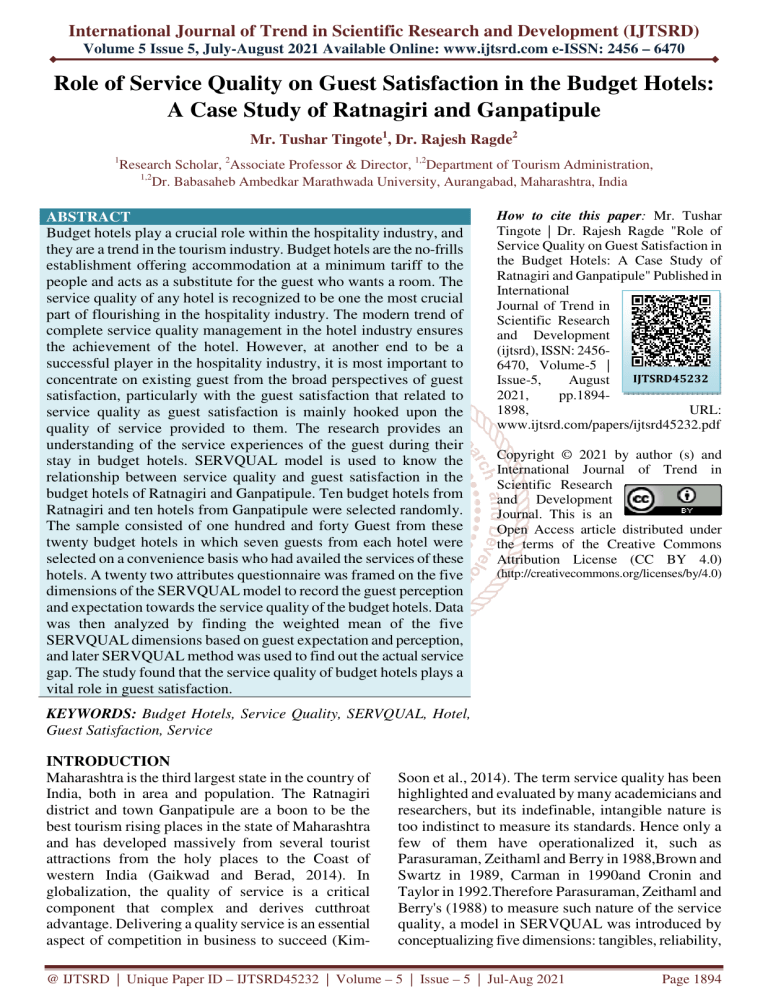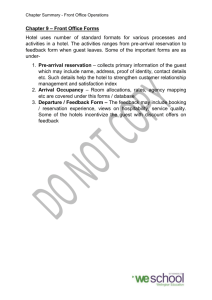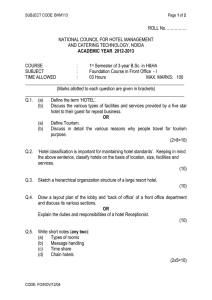
International Journal of Trend in Scientific Research and Development (IJTSRD)
Volume 5 Issue 5, July-August 2021 Available Online: www.ijtsrd.com e-ISSN: 2456 – 6470
Role of Service Quality on Guest Satisfaction in the Budget Hotels:
A Case Study of Ratnagiri and Ganpatipule
Mr. Tushar Tingote1, Dr. Rajesh Ragde2
1
Research Scholar, 2Associate Professor & Director, 1,2Department of Tourism Administration,
1,2
Dr. Babasaheb Ambedkar Marathwada University, Aurangabad, Maharashtra, India
ABSTRACT
Budget hotels play a crucial role within the hospitality industry, and
they are a trend in the tourism industry. Budget hotels are the no-frills
establishment offering accommodation at a minimum tariff to the
people and acts as a substitute for the guest who wants a room. The
service quality of any hotel is recognized to be one the most crucial
part of flourishing in the hospitality industry. The modern trend of
complete service quality management in the hotel industry ensures
the achievement of the hotel. However, at another end to be a
successful player in the hospitality industry, it is most important to
concentrate on existing guest from the broad perspectives of guest
satisfaction, particularly with the guest satisfaction that related to
service quality as guest satisfaction is mainly hooked upon the
quality of service provided to them. The research provides an
understanding of the service experiences of the guest during their
stay in budget hotels. SERVQUAL model is used to know the
relationship between service quality and guest satisfaction in the
budget hotels of Ratnagiri and Ganpatipule. Ten budget hotels from
Ratnagiri and ten hotels from Ganpatipule were selected randomly.
The sample consisted of one hundred and forty Guest from these
twenty budget hotels in which seven guests from each hotel were
selected on a convenience basis who had availed the services of these
hotels. A twenty two attributes questionnaire was framed on the five
dimensions of the SERVQUAL model to record the guest perception
and expectation towards the service quality of the budget hotels. Data
was then analyzed by finding the weighted mean of the five
SERVQUAL dimensions based on guest expectation and perception,
and later SERVQUAL method was used to find out the actual service
gap. The study found that the service quality of budget hotels plays a
vital role in guest satisfaction.
How to cite this paper: Mr. Tushar
Tingote | Dr. Rajesh Ragde "Role of
Service Quality on Guest Satisfaction in
the Budget Hotels: A Case Study of
Ratnagiri and Ganpatipule" Published in
International
Journal of Trend in
Scientific Research
and Development
(ijtsrd), ISSN: 24566470, Volume-5 |
IJTSRD45232
Issue-5,
August
2021,
pp.18941898,
URL:
www.ijtsrd.com/papers/ijtsrd45232.pdf
Copyright © 2021 by author (s) and
International Journal of Trend in
Scientific Research
and Development
Journal. This is an
Open Access article distributed under
the terms of the Creative Commons
Attribution License (CC BY 4.0)
(http://creativecommons.org/licenses/by/4.0)
KEYWORDS: Budget Hotels, Service Quality, SERVQUAL, Hotel,
Guest Satisfaction, Service
INTRODUCTION
Maharashtra is the third largest state in the country of
India, both in area and population. The Ratnagiri
district and town Ganpatipule are a boon to be the
best tourism rising places in the state of Maharashtra
and has developed massively from several tourist
attractions from the holy places to the Coast of
western India (Gaikwad and Berad, 2014). In
globalization, the quality of service is a critical
component that complex and derives cutthroat
advantage. Delivering a quality service is an essential
aspect of competition in business to succeed (Kim-
Soon et al., 2014). The term service quality has been
highlighted and evaluated by many academicians and
researchers, but its indefinable, intangible nature is
too indistinct to measure its standards. Hence only a
few of them have operationalized it, such as
Parasuraman, Zeithaml and Berry in 1988,Brown and
Swartz in 1989, Carman in 1990and Cronin and
Taylor in 1992.Therefore Parasuraman, Zeithaml and
Berry's (1988) to measure such nature of the service
quality, a model in SERVQUAL was introduced by
conceptualizing five dimensions: tangibles, reliability,
@ IJTSRD | Unique Paper ID – IJTSRD45232 | Volume – 5 | Issue – 5 | Jul-Aug 2021
Page 1894
International Journal of Trend in Scientific Research and Development @ www.ijtsrd.com eISSN: 2456-6470
responsiveness, assurance and empathy. In simple
words, service quality results from the efficiency
taken by the hotel staff to match the guest
expectations.
Service quality plays a crucial role in the success of
any hotel business. A hotel provides a feeling of
home away from home, and in this, it is essential to
identify the specific expectation or the guest in the
guest as a reason to have a better understanding of the
guest's specific needs (Akbaba, 2006). However, the
concept of budget hotels often declared as a 'boom' or
as representing one of the most critical trends in the
international hospitality industry(Fiorentino, 1995).
The budget hotel can be defined as economical
compared to the luxury hotel and only providing the
basic service and amenities (Teng, 2010). This
however the service quality of the budget hotels has a
great impact on the guest satisfaction as it deals with
the evaluation that's formed by the guest perception
by comparing their pre purchase expectations of what
they might receive from the hotel in terms of the
performance they really did receive (Oliver,
1980).Guest satisfaction is a overall result of the
perception of the guest towards the service in which
he evaluates his psychological reactions for the
service he availed Yi (1990)
The research objective is to study the role of the
Service Quality on Guest Satisfaction in the Budget
Hotels in Ratnagiri and Ganpatipule of Maharashtra
using the SERVQUAL model by applying its five
basic dimensions, i.e., Tangibles, Reliability,
Responsiveness, Assurance and Empathy.
Review of literature:
SERVQUAL model is found to be one of the best
models that have been used for many research in
measuring the service quality; it comparatively
emphasis the differentiation in the service quality
towards the guest expectation and perception, as a
guest assess the actual service experience delivered to
him within a stipulated time (Parasuraman, Zeithaml,
& Berry, 1985, 1991, 1994; Nasution&Mavondo,
2008). Parasuraman et al., 1985 stated that
SERVQUAL is a gap assessment tool in which the
gap between the guest expectation and perception
found results from the perceived service quality. It
denotes that the lesser the gap, the higher the service
quality and the higher the service gap, then the lesser
the service quality. Zeithaml et al. in 1988 defined
service quality as the degree and direction of a
discrepancy between consumers' perceptions and
expectations in terms of different but relatively
essential dimensions of service quality, which can
affect their future behavior. According to
Parasuramanet al. (1988), service quality can be
defined as an overall judgment similar to attitude
towards the service and generally accepted as an
antecedent of overall customer satisfaction.
Budget hotels are the establishments that target and
focus more on medium and small enterprise business,
budgeted tourists, youth class, etc. (Albattat,
2016).Quest 1983 defines budget hotel as a 'new
generation of budget hotels, mainly small and all with
limited facilities and a no-frills price'. However, Lee
11 1984, stated, A hotel referred to 'one of the fastestgrowing segments of the industry' offering 'clean,
simple room, a restaurant coffee shop is generally onsite nearby' is known as a budget hotel.
Statement of the problem:
The entire hospitality industry attempt and offers the
best of it to their guest and ensures to provide a high
quality of the services yet they lacks to match with
the guests' expectations as the guest has become more
aware of their requirements and demand superior
standards of service for meeting the particular
organization (Kumar et al., 2011).Hotels represent a
significant profession within the global agendas and
modern development trends of the hospitality industry
(Pavia et al., 2014). However, a series of new and
economic start-ups, including budget and midrange
hotels proving a no-frill accommodation is an
ongoing concept yet lacks the standard definition and
yet to fit in the existing category of the hotel business
(Fiorentino, 1995).Commonly there are numerous
constraints and difficulties in the operations of budget
hotels faced by hotel owners/managers (Masturaet al.,
2011). This came out to a significant research gap.
Therefore, the researcher has studied the service
quality of budget hotels distinctively at Ratnagiri and
Gapatipule, from the guest perception and expectation
through the SERVQUAL scale.
Objective:
The research's core objective is to study the role of
the Service Quality on Guest Satisfaction in the
Budget Hotels in Ratnagiri and Ganpatipule of
Maharashtra using the SERVQUAL model by
applying its five basic dimensions, i.e., Tangibles,
Reliability, Responsiveness, Assurance and Empathy.
Hypothesis:
Service quality of the Budget hotels in Ratnagiri and
Ganpatipule of Maharashtra is low from the guest
satisfaction.
Methodology:
The study evaluates the service quality of the budget
hotels in Ratnagiri and Ganpatipule of Maharashtra
through the guest expectation and perception study
using the SERVQUAL method. It is hypothesized
that the Service quality of the Budget hotels in
@ IJTSRD | Unique Paper ID – IJTSRD45232 | Volume – 5 | Issue – 5 | Jul-Aug 2021
Page 1895
International Journal of Trend in Scientific Research and Development @ www.ijtsrd.com eISSN: 2456-6470
Ratnagiri and Ganpatipule of Maharashtra is low
from the guest perspective. The study consists of both
primary and secondary data collection in which the
primary data collection was carried out through a
survey of 20 various budget hotels in Ratnagiri and
Ganpatipule and around its famous tourist destination
randomly selected. The hotels with the single room
tariff between Rs.1000-2000 were classified under
budget and midrange hotels. 07 guests were selected
on a convenience basis from each of the selected
hotels and were asked to fill the questionnaire to
know the service gap. Data were then analyzed using
the SERVQUAL method, a non-parametric test for
testing hypothesis towards guest perception with their
expectation. After an extensive review of the
literature, a 22 attributes questionnaire was framed on
the five dimensions of the SERVQUAL model to
record the guest perception and expectation towards
the hotels' service quality in Ratnagiri and
Ganpatipule and ultimately to know its role on the
guest satisfaction.
Data Analysis:
SERVQUAL method/model consists of five chief
attributes/dimensions, i.e. reliability, assurance,
tangibles, empathy and responsiveness. These
attributes help identify the actual gap, which is the
difference between guest expectations of service and
what they receive.
In the study, the data was then analyzed by finding
the weighted mean of the five servqual dimensions
based on guest expectation and perception; later on,
the actual service gap was found using the
SERVQUAL method. SERVQUAL model provides a
score for the guest expectation (E) likewise, a score
for the guest's perception (P) of the hotel
performances. Guest expectations are the wants and
requirements they carry in their mind before
consuming a service; what the guest wants should be
identified by the hotels, and accordingly, these are
considered a service aspect or standards (Miller,
1977).
Table 1: Weighted mean and overall SERVQUAL Gap of the budget hotels in Ratnagiri and Ganpatipule.
EXPECTATION PERCEPTION Servqual Gap
SERVQUAL DIMENSION
(Before stay)
(After stay)
(SQ=P-E)
RELIABILITY
Hotel room allocated and kept ready.
The hotel room equipment's functioning (A.C.,
Fan, T.V., lamp, phone, mini-bar, etc.)
Value for money (Hotel)
3.90
-0.34
3.57
The efficiency of the Check-in & Check out
Process.
Ability to provide service as promised
ASSURANCE
Safety & Security in the hotel
Hotel staff (Polite, Courteous, Friendly)
3.80
3.56
-0.24
Knowledge of the hotel staff to answer guest
queries
Quality of overall service
TANGIBLES
The first impression of the hotel(Visually
Appealing)
Grooming & Appearance of the hotel Staff
Cleanliness in the Hotel Room
3.78
3.56
-0.22
The comfort of the Furniture in the hotel room
(Bed, Table, Chair etc.)
Cleanliness in the lobby and Public area
EMPATHY
Staff’s concern about the benefits of the guests
Understanding of the guests’ specific needs
3.77
3.41
-0.36
Paying Individual attention
Complaint handling by the hotel staff
@ IJTSRD | Unique Paper ID – IJTSRD45232 | Volume – 5 | Issue – 5 | Jul-Aug 2021
Page 1896
International Journal of Trend in Scientific Research and Development @ www.ijtsrd.com eISSN: 2456-6470
RESPONSIVENESS
The willingness of the hotel staff to provide the
service
Promptness of the room service & another
3.73
department
Speed of response to guest request
Speed of response to guest Problems
Total
3.80
Results and Discussion
After comparing the service quality of the Ratnagiri
and Ganpatipule budget hotels through the
SERVQUAL method and its dimensions (i.e.
Reliability, Assurance, Tangibles, Empathy,
Responsiveness), the researcher found that the
maximum SERVQUAL gap between “expectation”
and “perception” of the guest was -0.38, whereas the
minimum gap found was -0.22. All the factors under
five SERVQUAL dimensions showed a negative
result in the difference between “expectations” and
“perception” (P-E). The widest gaps found in the
dimensions of “responsiveness” (-0.38) and in
“empathy” (-0.36) where the guest found better
physical evidence in the hotels, so the gap in the
dimension of “tangibles” is the narrowest (0.22).Also, the overall difference between
"expectations" and "perception" of the guest resulted
negative. This indicates that the Guests expectations
are not fulfilled as per their perception (post-stay),
which means that hotel guests' expectations are higher
than their perception, and therefore, this proves the
existence of a negative SERVQUAL gap in the
budget hotels of the Ratnagiri and Ganpatipule.
Conclusion& Suggestions:
This research helps in escalating the understanding of
the connection between service quality experience
and guest satisfaction in the budget hotels of the
Ratnagiri and Ganpatipule of Maharashtra state. The
overall service quality standards were comparatively
low in terms of the guest's expectation and perception
of who had availed the services.
To minimize the negative score gap between guests'
expectations and their perceptions, particularly with
the "responsiveness” dimension/attribute of
SERVQUAL,
the
following
are
the
recommendations.
Staff should inculcate the feeling of ownership.
-0.38
3.49
-0.31
It is the responsibility of every staff of the hotel
that they should work effectively and efficiently.
Recommendations to improve the score of the
Empathy dimension are as follows.
Hotel staff should consider very hotel guest as a
critical friend of him.
The employee should have a Self approach
attitude towards the guest.
Managers and the staff of the budget hotels in
Ratnagiri and Ganpatipule have to ensure for
discovering the needs, wishes and expectations of
the guests.
To offer a high-quality service to guests, all
budget hotels must utilize their employees with
success in skill development in training or
recruiting the trained workforce. The guest feed
should be taken from every guest of the hotel at
checkout; this will help to work on various parts.
References:
[1] Akbaba, A. (2006). Measuring service quality
in the hotel industry: A study in a business
hotel in Turkey. International journal of
hospitality management, 25(2), 170-192.
[2]
Alberta, Ahmad & Arifin¹, Ainshamimi&
Arifuddin¹, Sarwana& Ravi¹, Karthik&
Hendricks¹, Alfred. (, 2016). Service Quality
and Customer Satisfaction of Budget Hotel: A
Case Study of De Palma Hotel Shah Alam,
Malaysia.
[3]
Brown S W and Swartz T A (1989) A gap
analysis of professional service quality. Journal
of Marketing53: 92-8.
[4]
Carman J M (1990) Consumer perception of
service quality: An assessment of the
SERVQUAL dimensions. Journal of Retailing
66: 33-35.
[5]
Cronin J, Joseph Jr and Taylor S A (1992)
Measuring service quality: A re-examination
and extension. Journal of Marketing 56: 55-68.
Staff should be introduced to the basics of
hospitality standards.
The manager or the owner should then monitor
staff.
3.34
All staff should work as a team.
@ IJTSRD | Unique Paper ID – IJTSRD45232 | Volume – 5 | Issue – 5 | Jul-Aug 2021
Page 1897
International Journal of Trend in Scientific Research and Development @ www.ijtsrd.com eISSN: 2456-6470
[6]
Fiorentino, A. (1995). Budget hotels: not just
minor
hospitality
products. Tourism
Management, 16(6), 455-462.
[7]
Gaikwad, D. Y., &Berad, N. R. (2014,
October). NASHIK as a Tourist Destination:
Issues and Challenges. In Management
Education-Achieving Global Standard and
Recognition”(2014) in International seminar
on Management Education, held at Curtin
University Malaysia and BhartiVidyapeeth
University, Pune, 02nd and 03rd Oct.
[8]
[9]
[14]
Oliver, R. L. (1980). A Cognitive Model of the
Antecedents and Consequences of Satisfaction
Decisions. Journal of Marketing Research, Vol.
XVII, November.
[15]
Parasuraman A Zeithaml V A and Berry L L
(1988) SERVQUAL: A multiple-item scale for
measuring consumer perception of service
quality. Journal of Retailing 64: 12-40.
Kim-Soon, N., Rahman, A., &Visvalingam, L.
(2014). SERVQUAL: Can it be used to
differentiate the guest's perception of service
quality of 3 stars from a 4-star hotel.
International Business Research, 7(7), 37-47.
[16]
Parasuraman, A., Zeithaml, V., & Berry, L.
(1985). A conceptual model of service quality
and its implications for future research. Journal
of Marketing, 49, 41–50.
[17]
Kumar, B., Banga, G., &Thapar, J. (2011). An
assessment of the service quality of the hotel
industry.
Pacific
Business
Review
International, 4(1), 13-30.
Parasuraman, A., Zeithaml, V., & Berry, L. L.
(1991). Refinement and reassessment ofthe
SERVQUAL scale. Journal of Retailing, 67(4),
420–450.
[18]
Parasuraman, A., Zeithaml, V., & Berry, L. L.
(1994). Reassessment of expectations asa
comparison standard in measuring service
quality: Implications for further research.
Journal of Marketing, 58(1), 111–125.
[19]
Pavia, N. et al., (2014), “Specialization As A
Trend In Modern Hotel Industry”, 22nd
Biennial International Congress Tourism &
Hospitality Industry.
[20]
Quest, M 'Is there a future for low-tariff U.K.
hotels?' Caterer &Hotelkeeper 1983 (29
September) 55-61.
[21]
Yi, Y. (1990). A critical review of consumer
satisfaction. Review of Marketing 1990,
American Marketing Association, Chicago, IL.
[22]
Zeithaml V A, Berry L L and Parasuraman A
(1988) Communication and control processes in
delivering service quality. Journal of
Marketing52:35-38
[10]
Lee, D R '1: An introduction" in 'The budgets:
three views" Cornell H R A Quarterly 1984
(May).
[11]
Mastura, J., &Siti, Z. (2011). Problems of small
and medium budget hotel operators. World
Applied Sciences Journal, 12(T and H)), 73-79.
[12]
Miller, J.A. (1977), ``Studying satisfaction,
modifying models, eliciting expectations,
posing problems and making meaningful
measurements'', in Hunt, H.K. (Ed.),
Conceptualization and Measurement of
Consumer Satisfaction and Dissatisfaction,
Marketing Science Institute, Cambridge, MA,
pp. 72-91.
[13]
customer experience. International Journal of
Hospital Management, 27, 204–213.
Nasution, H. N., &Mavondo, F. T. (2008).
Customer value in the hotel industry: What
managers believe they deliver and what
@ IJTSRD | Unique Paper ID – IJTSRD45232 | Volume – 5 | Issue – 5 | Jul-Aug 2021
Page 1898







